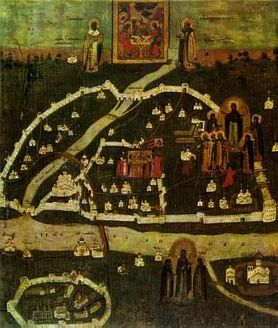 Pskov region. The fortress on the western border of Russia.
Pskov region. The fortress on the western border of Russia.
 The View of Pskov on the icon from the chapel of our Lord's Cross. The 18th century.
The View of Pskov on the icon from the chapel of our Lord's Cross. The 18th century.
From the 6 th up to the beginning of the 18 th century Pskov was in the center of historical events in Russia as an important political, administrative, and cultural center of trade and handicraft.
Pskov was also the strongest fortress on the western border of Russia. The oldest part of the town stands where the rivers Pskova and Velikaya join.
In the 8th centuries Pskov had grown into a rather big settlement with developed handicraft activity. But the development of a tribe settlement into a town happened later. From the 11th to 13th centuries Pskov became the second important town in Novgorod Land. At the beginning of the 14 century Pskov won independence from Novgorod. From the 14 th to the beginning of the 16 th century, Pskov was a city state. It was the capital of the independent land. Pskov Veche became an administrative organ. It adopted Pskovian Code Legislation, other laws, and amendments to the laws. It held disputes on all vital problems of life and policy.
In the middle of the Pershi wall there was a belfry in the shape of a small, tent - roofed tower where the bells of Trinity Cathedral hung. Two of these bells were especially important: one summoned the people to the veche, attended by all the people, and the other, to the state council. Pskov stood guard on the Russian land borders. The constant struggle of Pskov against foreign invaders led to the unification of Pskov with Moscow. The last Pskov Veche was session in 1510 when Grand Prince of Moscow Vasily III arrived in Pskov. In January 1510 Pskov lost the last vestige of republican rule, the Veche bell was removed and executed.
Guardian of the Russian Land!
The total length of the walls is 9,5 kilometers, the height up 12 to 20 meters and thickness up 2 to 6 meters. One German chronicler wrote about the Pskov citadel: "Their castle is so good that if they wish to settle their home affairs peacefully, none can capture their fortress." In the 16th century Pskov became the largest fortress in Russia. It was defended by four rings of stone walls fortified by 39 fighting towers.
A German historian wrote that Pskov gave the appearance of a very large town, in area many times bigger than others, and that no town in Germany could compare with it.
The history of Pskov counts a lot sieges and raids. But it was conquered only once - by the Livonian knights in 1240. So Pskov can really be called a guardian of the Russian Land!
Only after the Northern war of 1700 - 1721 did Pskov lose its military - strategic impotence.